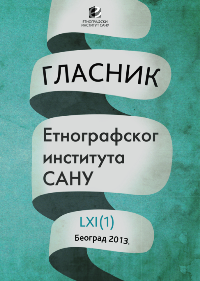Херој гитаре: од иконе популарне културе до носталгичног самодизајна
DOI: 10.2298/GEI1301187P УДК: 316.722:78(100)"19" 787.61.071.2.041.8(100)"19"
Сажетак
У раду се разматра преображај феномена „хероја гитаре” у популарној култури, од иконичне представе до модела подражавања. Херој гитаре, уобличен синтетизованим културним и технолошким формама, настао је након Другог светског рата. Током пола века свог постојања, модел поп-културног хероја гитаре трансформисан је од општепрепознатљиве представе са специфичним визуелним идентитетом и друштвеном функцијом до носталгичног предмета идентификације. Ова идентификација реализована је путем конзументских понуда и технолошких сила, опредмећених пре свега у производњи реплика инструмената „оригиналних” хероја гитаре, као и у развијању видео-игара које подражавају искуство гитарског наступа. Хероји су отишли у историју или митологију популарне културе, а њихово наслеђе остало је да траје између културног вредновања, сакрализовања реликвија и самодизајна у производним процесима потрошачког друштва.
Кључне речи: херој гитаре, популарна култура, популарна музика, наслеђе, носталгични самодизајн
Reference
Appadurai, Ajrun. 1996. Modernity at Large. Minneapolis: University of Minesota
Press.
Bennett, Andy, Dawe, Kevin. (eds.) 2001. Guitar cultures. Oxford - New York: Berg.
Bjerkvol, Jun-Ruar. 2005. Nadahnuto biće. Beograd: Plato.
Burrows, Terry (ed.). 2002. The Complete Book of the Guitar: The Definitive Guide to
the World's Most Popular Instrument, London: Carlton Books.
Buxton, David. 2000. Rock Music, the Star System, and the Rise of Consumerism. On
Record: Rock, Pop and the Written Word, Simon Frith, Andrew Goodwin (eds).
London-New York: Routledge. 366–377.
Carfoot, Gavin. 2006. Acoustic, Electric and Virtual Noise: The Cultural Identity of the
Guitar. Leonardo Music Journal, Vol. 16: 35–39.
Danesi, Marcel. 2007. Popular Culture: Introductory Perspectives. Maryland: Rowman
& Littlefield Publishers.
Гавриловић, Љиљана. 2011. Сви наши светови: о антропологији,научној
фантастици и фантазији. Београд: Етнографски институт.
Edensor, Tim. 2002. National Identity, Popular Culture and Everyday Life. Oxford -
New York: Berg.
Fernandez Karen V., Lastovicka John L. 2011. Making Magic: Fetishes in
Contemporary Consumption. Journal of Consumer Research, Vol. 38, (August): 1–
23.
Frith, Simon. 1981. Sound Effects: Youth, Leisure, and the Politics of Rock and Roll.
New York: Pantheon.
Frith, Simon, Andrew Goodwin (eds). 2000. On Record: Rock, Pop and the Written
Word, . London-New York: Routledge.
Grossberg, Lawrence. 1983. The politics of youth culture: Some observations on rock
and roll in American culture. Social Text 8: 104–126
Groys, Boris. 2009. Self-Design and AestheticResponsibility. e-flux journal #7 (JuneAugust):
1–8.
Hempstead, Colin; Worthington, William E. 2005. Encyclopedia of 20th-century
technology, Volume 2. Oxford-New York: Taylor & Francis.
Millard, A. J. (ed.) 2004. The electric guitar: a history of an American icon. Baltimor:
The John Hopkins University Press.
Miller, Kiri. 2009. Schizophonic Performance: Guitar Hero, Rock Band, and Virtual
Virtuosity. Journal of the Society for American Music, Volume 3, Number 4: 395–
429.
Montague, Eugene, 2003. Skill, Music, and Energy in Punk Performance, Practising
Popular Music: Proceedings of the 12th Biennial IASPM-International Conference,
Alex Gyde and Geoff Stahl (eds.). Montréal: 643–648.
Mukerji, Chandra, Michael Schudson, 1986. Popular Culture, Annual Review of
Sociology, Vol. 12: 47–66
Nelson, Wade, 2003. Dialed Tone: Signature Guitars as Cultural Signifiers, Practising
Popular Music: Proceedings of the 12th Biennial IASPM-International Conference,
Alex Gyde and Geoff Stahl (eds.). Montréal: 681–688.
Owram Doug 1997. Born at the Right Time: A History of the Baby Boom Generation,
Toronto: University of Toronto Press.
Perković, Ante. 2011. Sedma republika: pop kultura u Yu raspadu, Zagreb: Novi Liber,
Beograd: Službeni glasnik.
Pichaske, David R., 1979. A generation in motion: Popular music and culture in the
sixties, New York: Schirmer Books.
Popadić, Milan. 2012. Čiji je Mikelanđelov David? Baština u svakodnevnom životu.
Beograd: Centar za muzeologiju i heritologiju Filozofskog fakulteta u Beogradu.
Rozin, Paul, Linda Millman, Carol J. Nemeroff. 1986. Operation of the Laws of
Sympathetic Magic in Disgust and Other Domains, Jurnal of Personality and Social
Psyhology, 50 (4): 703–712.
Stevanović, Lada. 2008. Human or Superhuman: the Concept of Hero in Ancient Greek
Religion and/in Politics, Glasnik Etnografskog instituta SANU LVI (2): 7–22.
Strinati, Dominic. 2005. An Introduction to Theories of Popular Culture. London - New
York: Routledge.
Waksman, Steve. 2001a. Instruments of Desire: The Electric Guitar and the Shaping of
Musical Experience. Harvard: Harvard University Press.
Waksman, Steve, 2001б. Into the Arena: Edward Van Halen and the Cultural
Contradictions of the Guitar Hero. Guitar Cultures. Andy Bennett and Kevin Dawe
(eds). Oxford and New York: Berg.
Жикић, Бојан. 2012. Поп песма: епистоларна форма популарне културе,
Етноантрополошки проблеми н.с., год. 7. св. 2. (2012): 408–508.
<https://www.ei.sanu.ac.rs/index.php/gei/article/view/389>.
Датум приступа: 24 nov. 2025






